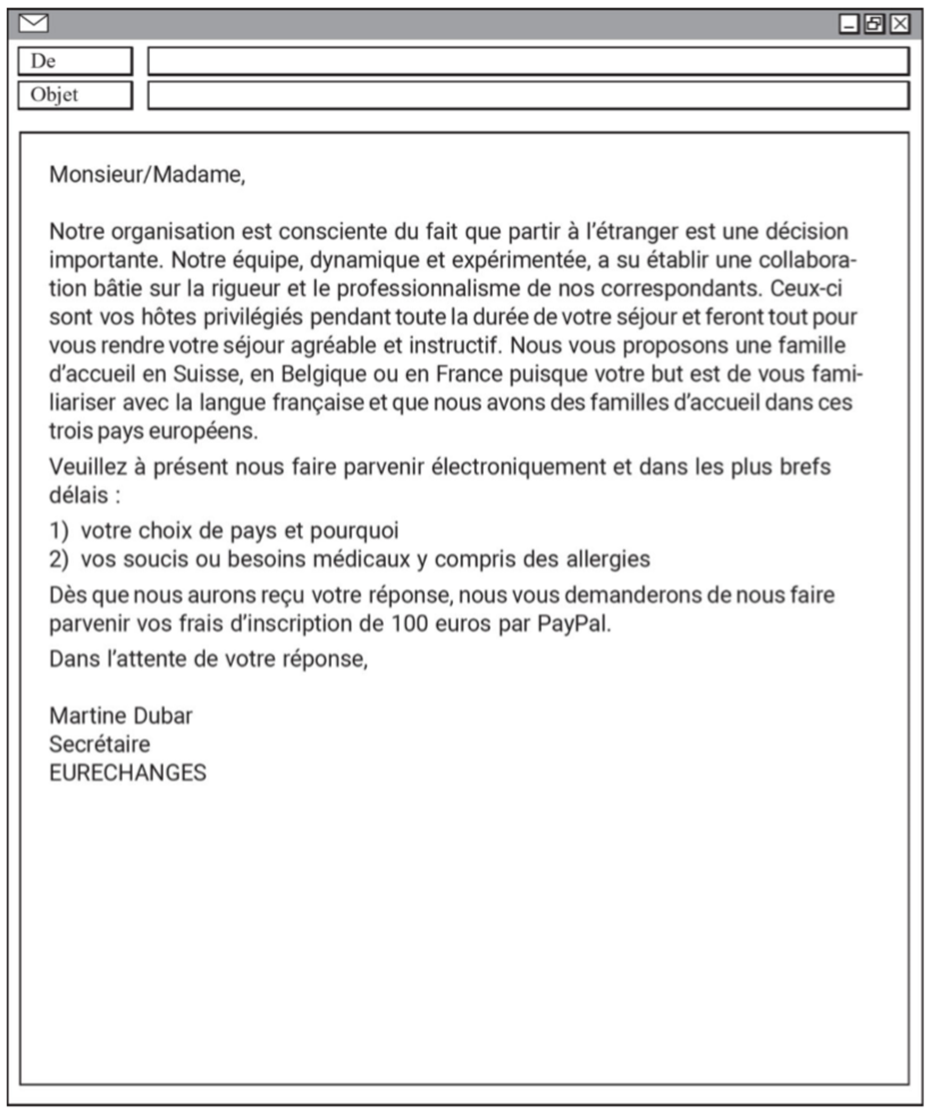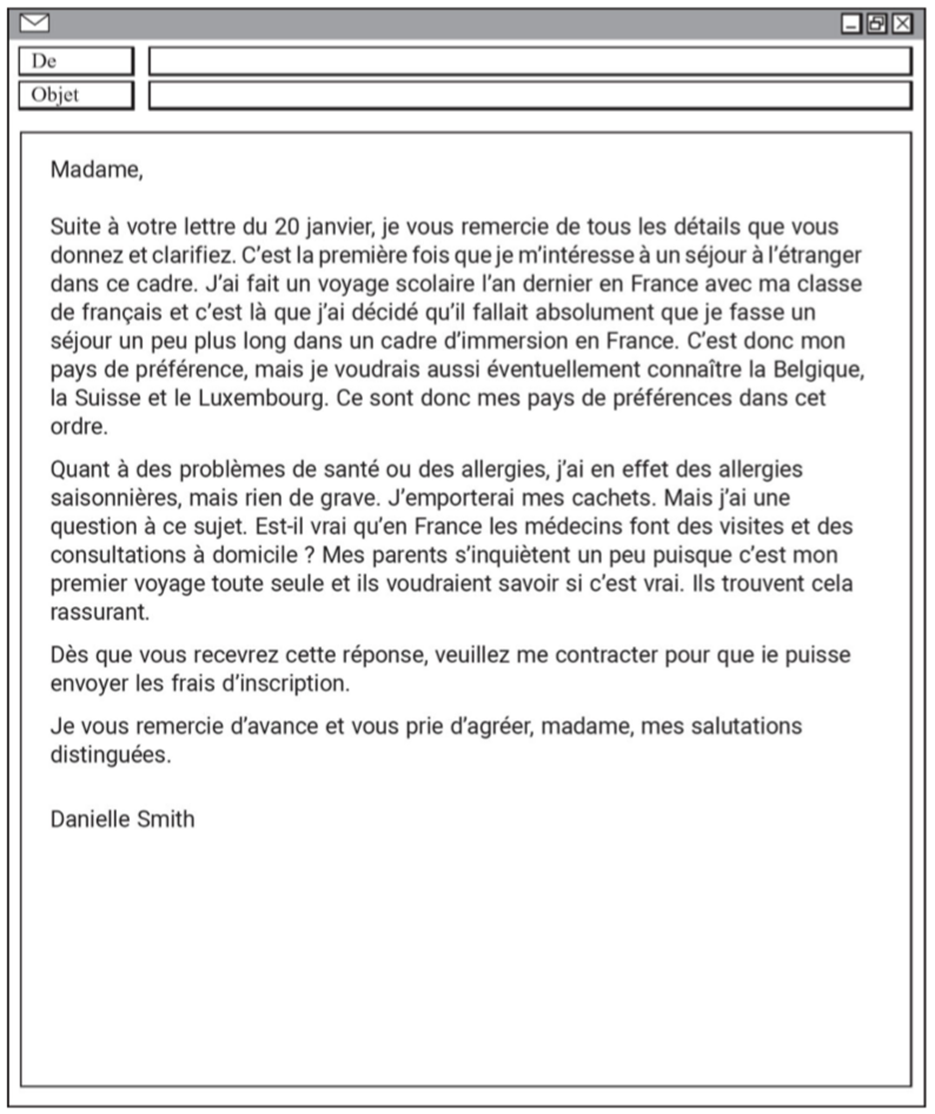Chapter 4: Writing Email Replies
A. Instructions, Strategies, and Tips
- While reading the email, underline or ==highlight key words==. Doing this will prompt you to elaborate on these key ideas.
- ==Give a concise reply==. However, elaborate on some key ideas and respond to all questions.
- ==Use a formal approach== in both language and tone. Use vous consistently as necessary.
- Do not use the “pitch of voice” interrogative approach
- Try using the inversion interrogative structure as much as possible; “Pourriez-vous me renseigner . . .?” rather than “Vous pourriez me renseigner . . .?”
- ==Ask for details.==
- If you recognize references to a particular francophone culture in the email, try to ==show your understanding of the special features== of the culture in your response.
- ==Organize your response==; indent and follow standard writing conventions (capitalization, spelling, accent marks, and etc).
- ==Use a mix of simple and complex sentences.== Use transitional phrases.
- ==Use precise and idiomatic vocabulary== as well as a variety of grammatical structures.
- Be sure to include ==an opening== to the letter as well as ==a closing==. Preferably, these should be different from the one used in the email to which you are writing a reply.
B. Useful Vocabulary for Emails
Opening an Email
In the event you are writing to a totally unknown person, use this form of address:
- Monsieur, Madame,
To whom it may concern,
If you have met the person and have established a closer yet formal relationship, you may also use one of the following forms of address:
- Cher monsieur,
Dear sir,
- Cher monsieur Dupont,
Dear Mr. Dupont,
- Chère madame,
Dear mada
- Chère madame Flaubert,
Dear Mrs. Flaubert,
With individuals who bear a professional title, use Monsieur or Madame followed by the professional title:
- Monsieur le Directeur/Madame la Directrice,
Dear Director,
- Monsieur le professeur/Madame le professeur,
Dear Professor,
- Monsieur le docteur/Madame le docteur,
Dear Doctor,
Note: The use of mademoiselle is ==no longer acceptable in official correspondence.==
Closing an Email
French closings in letters tend to be long and flowery. However, ==formal closings in emails tend to be much shorter.==
Here are a few examples that are all equivalents of a simple sincerely:
- Cordiales salutations,
- Cordialement,
- Bien cordialement,
- Bien à vous,
- Sincères salutations,
- Avec mes salutations les plus cordiales,
- Sentiments distingués,
- Avec reconnaissance,
- Recevez mes sentiments respectueux,
Other Expressions Used in an Email:
- Je vous remercie de votre réponse.
I thank you for your answer.
- Je vous remercie de m’avoir répondu dans un si bref délai.
I thank you for having answered so promptly.
- Je vous suis reconnaissant(e) de m’avoir contacté(e).
I thank you for having contacted me.
- Merci d’avance.
I thank you in advance.
- Avec mes remerciements.
Many thanks.
- J’attends votre réponse.
I am looking forward to your answer.
- Dans l’attente de votre réponse.
Looking forward to your answer.
- Dans l’attente d’une réponse favorable.
Pending a favorable response.
C. Essential Vocabulary Contained in Emails on Previous AP French Language and Culture Exams
- donner suite à: Nous allons donner suite à votre demande.
We will consider your request.
suite à votre demande: Suite à votre demande, nous confirmons les dates de votre séjour.
To follow up on your request, we confirm the dates of your stay.
prier: Nous vous prions de répondre immédiatement.
Please answer immediately.
envisager: Vous devriez envisager un nouveau plan.
You should contemplate a new plan.
les moyens: Quels moyens de transport préférez-vous?
What means of transportation do you prefer?
la bourse: Nous accordons des bourses d’étude.
We grant scholarships.
la formation: Nous offrons une formation de deux semaines.
We offer a two-week training.
le stage: Le stage aura lieu en juin.
The internship will take place in June.
les démarches: Suivez les démarches ci-joint.
Follow the attached/enclosed steps.
le renseignement: Nous avons besoin de renseignements.
We need some information.
le concours: Inscrivez-vous au concours!
Sign up for the contest!
les frais: Nous rembourserons les frais.
We will reimburse the expenses.
l’hébergement: L’hébergement est compris.
Lodging is included.
les plus brefs/les meilleurs délais: Répondez dans les meilleurs délais.
Answer as soon as possible.
le poste: Je voudrais poser ma candidature pour le poste de moniteur de ski.
I would like to apply for the ski instructor job.
D. Writing the Email Response
- Synthesizing and Interpreting the Message
- What was the ==nature of the comment== or narrative in the written correspondence (information, invitation, announcement, request for help)?
- What is the ==main idea==?
- What ==specific information== was asked for in the written message?
- What ==type of reaction, reply, or follow-up== does the written message require?
- What ==key vocabulary== from the written stimulus (if any) can be used (recycled) or modified in order to produce a response?
- Writing an Appropriate Response
- ==Open and close your written correspondence== with appropriate and culturally relevant conventional phrases.
- ==Be sure to respond appropriately== to the message. That may mean expressing interest or surprise, agreeing or disagreeing, accepting or turning down a request, asking for details, and so on.
- ==Answer fully== by providing as much information as possible while adhering to the context of the task.
- ==Paraphrase== if you do not know the exact word for something. For instance, if you can’t think of phrase “séjour à l’étranger” to talk about “a stay in a foreign country,” just say “quand on reste dans un pays comme la France” or “quand on fait un voyage international.”
- Icing on the Cake
- Use ==formal transitional phrases== such as “de plus,” “en revanche,” “je me permets de vous faire remarquer,” or “je vous suis reconnaissant(e).”
- Use a ==variety of descriptive adjectives== as appropriate such as “une expérience mémorable,” “une œuvre bénévole,” and so on.
- Use ==adverbs== such as “sérieusement,” “profondément,” and “indubitablement” to strengthen the meaning of your verbs.
- Try to use a variety of ==precise verbs above and beyond the basic== “être,” “avoir,” and “faire.”
- Try to use ==idiomatic structures== such as “Cela m’intéresse” (rather than “je suis intéressé(e)”) and “Cette idée me plaît” (rather than “J’aime cette idée”).
- Use a ==variety of tenses== as correctly as possible. A sentence such as “Je suis enchanté(e) que vous me demandiez . . .” is sure to impress the reader.
- Use a ==few complex sentences== such as “Votre organisation est internationale alors que mon club est local.” Just elaborate on a main clause by ==using conjunctions== such as “parce que,” “alors,” “que,” “pourvu que,” “afin que,” and so on.
- Upon finishing your email reply, y==ou may sign off with a name or you may use a series of x’s as a placeholder for a signature==. Just know that any signature will be hidden from the reader who will score the task.
E. The “Big 5” for Email Success
- An opening greeting
- An answer to question #1 (the original email generally contains 2 questions)
- An answer to question #2
- A request for additional information (the item most often forgotten by students)
- A closing
F. Instructions, Email Prompts, and Exemplary Replies
The writing portion of the AP French Language and Culture exam tests your ability to read and write a formal response to an email.
You will have a total of 15 minutes to read the original email and write your response.
·Note that the instructions appear in both French and English. Choose one language in which to read your instructions.
Here is one example of the instruction you can expect to be given for this portion of the exam:
Sélection 1
Thème du cours: Vie contemporaine/Quête de soi
You will write a reply to an email message. You have 15 minutes to read the message and write your reply.
Your reply should include a greeting and a closing and should respond to all the questions and requests in the message. In your reply, you should also ask for more details about something mentioned in the message. Also, you should use a formal form of addres
Vous allez répondre à un courrier électronique. Vous aurez 15 minutes po lire le message et composer une répon.
Votre réponse doit commencer par salutation et se terminer par une formu de politesse. Vous devez répondre à toutes les questions et à toutes les demandes du message. Dans votre réponse, vous devez demander des détails sur un sujet évoqué dans le courrier. Vous devez utiliser un registr de langue soutenu.
INTRODUCTION
C’est un message électronique de Martine Dubar, de l’agence EURECHANGES, qui vous invite à présenter votre candidature pour être accueilli dans une famille francophone en Europe.

Exemplary Reply for Sélection 1

G. Justification of Excellent Performance
- ==Concise reply, response to all questions==: Early in her email, Danielle answered the questions about when she could come to Europe and which country she would prefer to visit. The last sentence confirms that she is sending all required documents asked for in the email.
- ==Formal approach in both language and tone==: Danielle uses a formal approach throughout. For example, she uses the inversion for interrogative structures and the formal veuillez for please.
- ==Elaboration, going into the details about something that appeared in the original message==: After addressing the topic of allergies that appeared in the original email, Danielle wants to know more about medical care and insurance. She elaborates on the topic of allergies and health.
- ==Opening and closing the letter==: Danielle uses an appropriate and formal opening and closing for her letter, which are different from what appeared in the original email, “Madame” and “Je vous remercie d’avance et vous prie d’agréer, madame, mes salutations distinguées.”
- ==Culturally relevant responses==: Danielle shows her knowledge of French culture by mentioning home visits by doctors.
- ==Variety of sentences==—both simple and complex. Danielle uses good transitions (suite à, quant à, donc, à ce sujet). The vocabulary is precise, and the grammar is accurate.